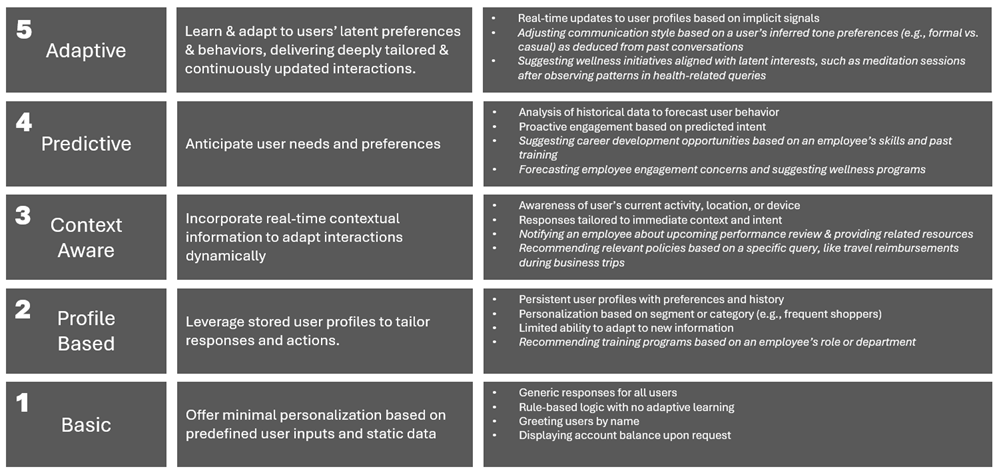Personalization Maturity Model for Agentic Conversational AI
Overview
The Personalization Maturity Model (PMM) for Agentic Conversational AI outlines the stages of growth and sophistication in creating personalized user interactions. As enterprises progress through these stages, their chatbots evolve to deliver more relevant, engaging, and context-aware experiences, ultimately driving higher user satisfaction and business value.
Stages of Maturity
1. Basic Personalization
- Description: Chatbots offer minimal personalization based on predefined user inputs and static data.
- Characteristics:
- Generic responses for all users.
- Limited use of user profiles (e.g., name or account details).
- Rule-based logic with no adaptive learning.
- Examples:
- Greeting users by name.
- Displaying account balance upon request.
- Answering frequently asked questions, such as "What are the office hours?"
- Directing users to static resources, like company handbooks or policies.
2. Profile-Based Personalization
- Description: Chatbots leverage stored user profiles to tailor responses and actions.
- Characteristics:
- Persistent user profiles with preferences and history.
- Personalization based on segment or category (e.g., frequent shoppers).
- Limited ability to adapt to new information.
- Examples:
- Recommending training programs based on an employee's role or department.
- Automatically populating forms with the employee's stored information (e.g., ID, department, manager).
- Sending reminders for expiring benefits or incomplete tasks, like timesheet submissions.
- Highlighting upcoming events relevant to the user's team or department.
3. Context-Aware Personalization
- Description: Chatbots incorporate real-time contextual information to adapt interactions dynamically.
- Characteristics:
- Awareness of user's current activity, location, or device.
- Integration with external systems (e.g., CRM, IoT devices).
- Responses tailored to immediate context and intent.
- Examples:
- Notifying an employee about their upcoming performance review and providing related resources.
- Offering assistance with benefits enrollment during the open enrollment period.
- Recommending relevant policies based on a specific query, like travel reimbursements during business trips.
- Suggesting real-time IT troubleshooting tips based on current device usage.
4. Predictive Personalization
- Description: Chatbots anticipate user needs and preferences using machine learning and predictive analytics.
- Characteristics:
- Analysis of historical data to forecast user behavior.
- Proactive engagement based on predicted intent.
- Continuous improvement through feedback loops.
- Examples:
- Suggesting career development opportunities based on an employee's skills and past training.
- Proactively reminding managers of pending approvals for leave or expense reports.
- Forecasting employee engagement concerns and suggesting wellness programs.
- Notifying employees of potential skill gaps and offering relevant learning paths.
5. Adaptive-Personalization
- Description: Chatbots deliver deeply personalized interactions by learning user's latent preferences.
- Characteristics:
- Real-time, multi-source data aggregation (e.g., social media, transaction history).
- Emotionally intelligent responses recognizing tone and sentiment.
- Cross-channel continuity and personalization.
- Examples:
- Delivering empathetic responses to employee grievances, recognizing tone and sentiment.
- Providing personalized wellness recommendations based on work patterns and feedback from engagement surveys.
- Designing tailored career progression plans considering an employee's aspirations and organizational goals.
- Offering seamless support for multi-channel queries (e.g., transitioning from chat to email without losing context).

Factors Driving Maturity
- Data Availability and Quality: The richness and accuracy of user data are foundational for advanced personalization.
- Technology Infrastructure: Sophisticated AI models, robust integrations, and real-time analytics enable higher levels of personalization.
- User-Centric Design: A deep understanding of user behavior, needs, and preferences guides meaningful personalization efforts.
- Organizational Commitment: Investment in technology, training, and cross-functional collaboration ensures sustainable maturity growth.
Benefits of Personalization Maturity
- Enhanced user satisfaction and loyalty.
- Improved operational efficiency through targeted automation.
- Higher conversion rates and revenue growth.
- Strengthened brand differentiation.
Challenges and Considerations
- Balancing personalization with user privacy and data security.
- Managing the complexity of integrations and dependencies.
- Ensuring scalability and adaptability to changing user needs.
Conclusion
Enterprises must align their chatbot personalization strategy with their broader business goals and technical capabilities. By advancing through the stages of the PMM, they can unlock the full potential of personalized chatbot interactions to deliver exceptional value to users and stakeholders.
Let us create detailed examples for each stage in the context of an HR chatbot to illustrate their application and impact, focusing on scenarios such as recruitment assistance, employee onboarding, performance management, and benefits queries.
Detailed Examples in the Context of an HR Chatbot
1. Basic Personalization:
- Greeting new employees by their name during onboarding.
- Providing predefined FAQs such as "What is the leave policy?" or "How do I reset my password?"
- Sharing a general welcome message during the first login.
- Offering links to company-wide announcements or holiday calendars.
2. Profile-Based Personalization:
- Recommending training programs based on an employee's role or department.
- Automatically populating forms with the employee's stored information (e.g., ID, department, manager).
- Sending personalized notifications about work anniversaries or birthday greetings.
- Suggesting relocation policies for employees flagged for internal transfers.
3. Context-Aware Personalization:
- Notifying an employee about their upcoming performance review and providing related resources.
- Offering assistance with benefits enrollment during the open enrollment period.
- Highlighting travel policy specifics when the employee is booking a business trip.
- Detecting prolonged inactivity and prompting employees to complete pending tasks.
4. Predictive Personalization:
- Suggesting career development opportunities based on an employee's skills and past training.
- Proactively reminding managers of pending approvals for leave or expense reports.
- Identifying employees at risk of burnout based on recent work patterns and recommending wellness sessions.
- Predicting future resource needs for departments and notifying managers for proactive hiring decisions.
5. Hyper-Personalization:
- Delivering empathetic responses to employee grievances, recognizing tone and sentiment.
- Providing personalized wellness recommendations based on work patterns and feedback from engagement surveys.
- Designing tailored career progression plans considering an employee's aspirations and organizational goals.
- Offering seamless support for multi-channel queries (e.g., transitioning from chat to email without losing context).
- Using voice recognition to identify and greet employees personally in hybrid environments.